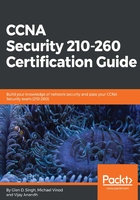
Transposition cipher
A transposition cipher simply manipulates the order or sequence of the message instead of trying to hide the message itself. There are many different transposition methods, one of which is known as columnar transposition. This variation uses the words of the message without spaces, where the width of the column itself is a fixed size and if there are any spaces remaining at the end of the last row, random characters are added to ensure the rows and columns are equal.
An example of columnar transposition while using the message the quick brown fox jumps over the lazy dog would result in the following:
thequi
ckbrow
nfoxju
mpsove
rthela
zydogz
Another version of a transposition cipher is the rail fence cipher. This version hides some of the characters of a message. Once again, we'll use the sentence the quick brown fox jumps over the lazy dog to demonstrate how the rail fence cipher works. The following is the result of the rail fence cipher:
t . . . u . . . b . . . n . . . j . . . s . . . r . . . l . . . d . .
Notice that there is a consistent thread where three characters are missing and there are no spaces between words. Each period (.) represents that a character is missing.